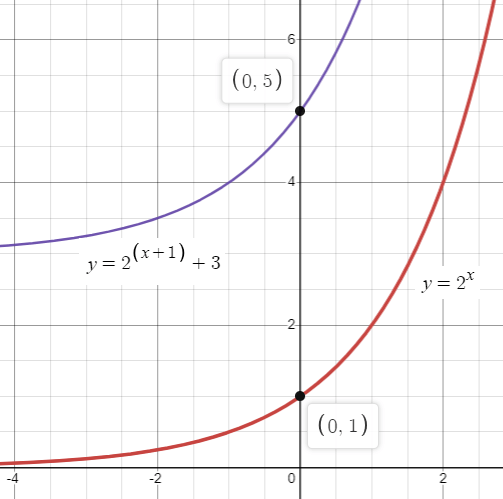GRAPHING EXPONENTIAL FUNCTIONS AND FIND DOMAIN AND RANGE
Subscribe to our ▶️ YouTube channel 🔴 for the latest videos, updates, and tips.
Graph each function. State the domain and range.
Problem 1 :
f(x) = 2x
Solution :
Applying some random values for x, we will receive the values of y.
When x = -2, f(-2) = 2-2 ==> 1/4
When x = -1, f(-1) = 2-1 ==> 1/2
When x = 0, f(0) = 20 ==> 1
When x = 1, f(1) = 21 ==> 2
When x = 2, f(2) = 22 ==> 4
(-2, 1/4) (-1, 1/2) (0, 1) (1, 2) and (2, 4)

Domain is (-∞, ∞) and range is (0, ∞)
Problem 2 :
f(x) = 2x+1 + 3
Solution :
Using the concept of transformation, we can draw the graph of the exponential function.
Comparing the given exponential function with general form
f(x) = a bx-h + k
f(x) = 2x - (-1) + 3
Here h = -1 and k = 3
Horizontally move the graph f(x) = 2x left 1 unit and vertically move the graph 3 units up.

Horizontal asymptote y = 3
Domain is (-∞, ∞) and range is (3, ∞)
Problem 3 :
f(x) = 3x-2 + 4
Solution :
First let us find the graph of the parent function g(x) = 3x
Applying some random values for x, we will receive the values of y.
When x = -2, f(-2) = 3-2 ==> 1/9
When x = -1, f(-1) = 3-1 ==> 1/3
When x = 0, f(0) = 30 ==> 1
When x = 1, f(1) = 31 ==> 3
When x = 2, f(2) = 32 ==> 9
(-2, 1/9) (-1, 1/3) (0, 1) (1, 3) and (2, 9)
By joining the points, we will get the graph of f(x) = 3x
Using the concept of transformation, we can draw the graph of the exponential function.
Comparing the given exponential function with general form
f(x) = a bx-h + k
f(x) = 3x-2 + 4
Here h = 2 and k = 4
Horizontally move the graph g(x) 2 units right and 4 units up.

Problem 4 :
f(x) = 3(2)x + 8
Solution :
Considering the parent function be g(x) = 2x
Vertical stretch of 3 units and vertically move the graph 8 units up.

Problem 5 :
The graph of y = (2/3)x is shown

What is the range ?
a) x ∈ R b) 0 ≤ y < 1 c) y ≥ 1 d) y > 0
Solution :
The given function is decreasing function. The range is y > 0.
Problem 6 :
How would the range of the function y = 600 (3)x be affected if the function were changed to y = 800 (3)x ?
a) It changes from y ≥ 600 to y ≥ 800.
b) It would not be affected.
c) It changes from y > 0 to y < 0.
d) It changes from y < 0 to y > 0.
Solution :
Let f(x) = 600 (3)x and g(x) = 800 (3)x
To get the function the function g(x) from f(x)
= (4/3) ⋅ 600 (3)x
Vertical shift and stretch of 4 units and 1/3 units respectively
Considering the vertical asymptotes, for f(x) and g(x) the vertical asymptote is y = 0.
Problem 7 :
What is the range of the function
y = -10 (1/10)x
a) y > 0 b) y < 0 c) y < -10 d) y > 10
Solution :
From the function, y = -10 (1/10)x
a = 10, b = 1/10 which is in between 0 and 1.
Since we have negative coefficient, it must have reflection about x-axis along with decay. Horizontal asymptote is y = 0, then its range will be y < 0.
Problem 8 :
What is the domain of the function y = 1500(1.16)x ?
a) y > 0 b) x > 0 c) x ∈ R d) 0 < x < 1.16
Solution :
y = 1500(1.16)x
Here a = 1500 and b = 1.16
The value of b is greater than 1, so it must be the exponential growth function. Here we should find domain for the given exponential function, considering all possible inputs, x ∈ R option c is the answer.
Problem 9 :
What is the range of the function
g(x) = 72(0.92)x ?
a) y ≥ 72 b) y > 72 c) y > 0 d) y < 0
Solution :
Here a = 72 and b = 0.92 which lies in between 0 and 1.
It is a decay function and horizontal asymptote is at y = 0.
When x approaches -∞, the output will reach ∞. When x approaches +∞, the output will approach 0. So, the range is y > 0
Problem 10 :
How would the range of the function y = 16(0.75)x be affected if the function were changed to y = -16(0.75)x ?
a) It remains the same.
b) It changes from y > 16 to y < -16.
c) It changes from y < 0 to y > 0
d) It changes from y > 0 to y < 0
Solution :
By considering the function y = 16(0.75)x
a = 16 and b = 0.75 which lies between 0 and 1.
Then it must be a decay function. Finding the graph of the other, their must be a reflection about x-axis since we have negative coefficient.
So, the answer is option d.
Subscribe to our ▶️ YouTube channel 🔴 for the latest videos, updates, and tips.
Recent Articles
-
Finding Range of Values Inequality Problems
May 21, 24 08:51 PM
Finding Range of Values Inequality Problems -
Solving Two Step Inequality Word Problems
May 21, 24 08:51 AM
Solving Two Step Inequality Word Problems -
Exponential Function Context and Data Modeling
May 20, 24 10:45 PM
Exponential Function Context and Data Modeling